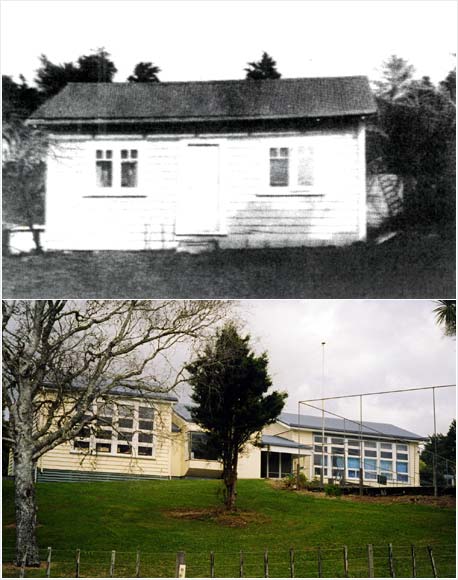
Piripiri school in 1927 and 2009.
What\'s you story?
Contributed by Grace Shaw
An aided school is probably unheard of nowadays. It was a small school where the parents of the children had to supply board for the teacher, whose salary was five pounds a month (which seemed a fortune then). The teacher had to shift around the families every term. Three of the families were dairy farmers, so the main meal of the day was in the late evening, but the other family were sheep farmers and had ‘high tea’ at 5.15, which took a bit of adjusting to. At the first three places I would have a big afternoon tea to see me through till the main meal much later, but at the fourth place I dared not have much to eat on arriving home from school, or I couldn’t eat the dinner, which was early. However it was a long time to bedtime and by then my tummy was rumbling with hunger.
I have often wondered what one family, Bill and May Howard, thought when I arrived in my heavy school shoes, home-made dress and my mother’s old coat. When my patched flannelette knickers went on the line I’m sure there was many a raised eyebrow as well. This delightful family treated me like a daughter. After my first pay cheque I came back from the holidays wearing a new twinset, skirt, light shoes and a jaunty hat. Mrs Howard told me later they wondered who their visitor was when I walked up the track to the house.
The school was built by the parents on a school reserve. They scrounged timber, windows, iron and a door. It was a small neat building with a backdrop of native bush that had a bubbling stream running through it. In front of the school was a large flat, covered in ti trees with hundreds of lancewoods. When summer came, bush locusts sang loudly all day long. This flat is now a lush grassy paddock.
The fern around the school was waist high, there was no water tank, no toilet, no books – just six very old desks and a teacher’s table, nothing else. We all took bottles of water to school till a tank and then a toilet were put in. Gradually some teaching aids arrived and we settled down to the job. Once the tank was up a little Dover stove was installed, as well as green blackboards, which were put around the walls.
Two families were close to the school, but the two others were three miles away along rough metalled roads. One place had two small children and on the first morning an old placid horse was caught, the child of six was placed behind clutching my ribs and a small boy of five was put in front of me on a cushion. Halfway to school it started to rain and the boy slipped sideways. I gave the cushion a yank and the cover split open, so we arrived at school smothered in wet feathers. At the end of the day I had to catch the horse again and try, without assistance, to remount the horse and somehow get two little children back in position – one in front and one behind! After that I decided to walk the three miles with the children trailing behind.
Using this item
Private collection
This item has been provided for private study purposes (such as school projects, family and local history research) and any published reproduction (print or electronic) may infringe copyright law. It is the responsibility of the user of any material to obtain clearance from the copyright holder.




















Add new comment